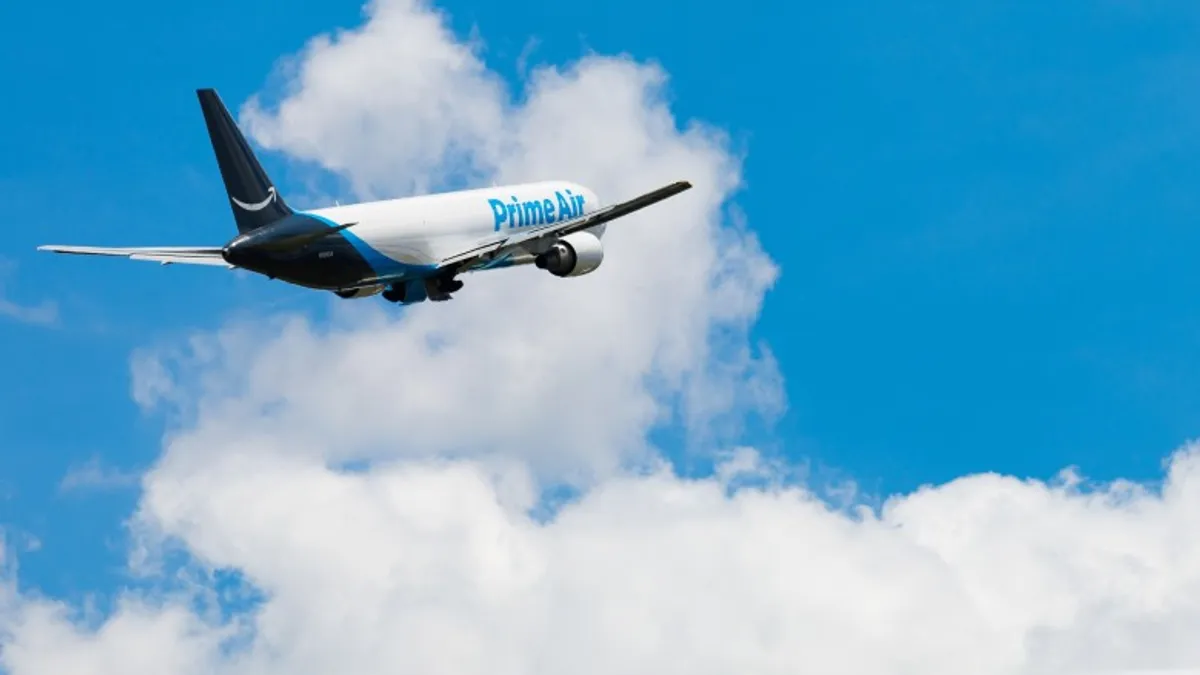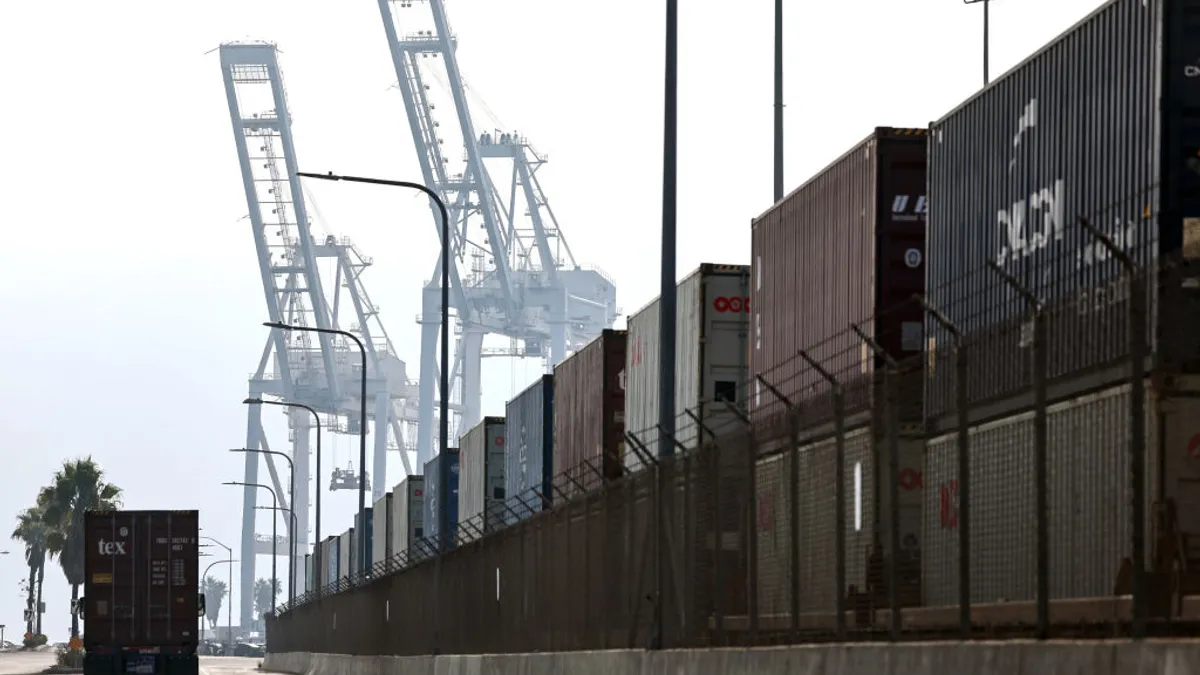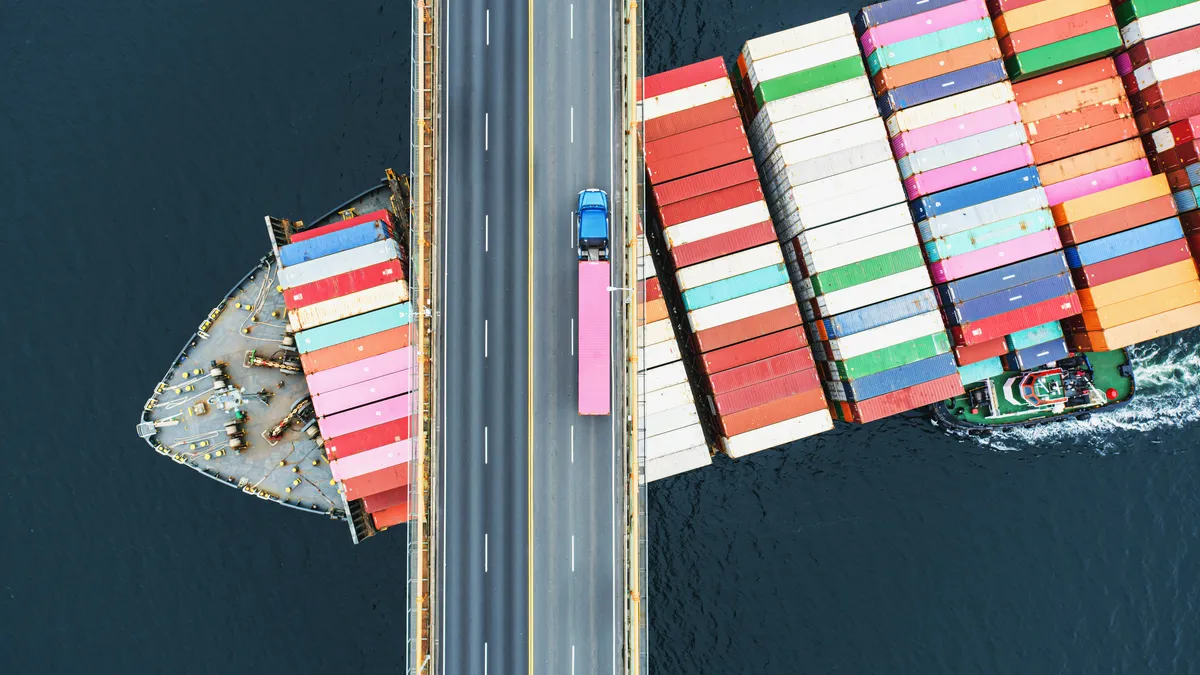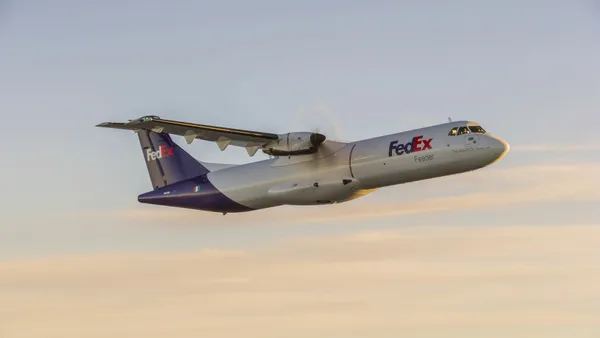Amazon Air is adding capacity to its fleet by leasing 12 Boeing 767-300 converted cargo aircraft from Air Transport Services Group, the company announced Wednesday. The new planes will bring the company's fleet to 82 planes by the end of next year, five years after announcing its first aircraft.
"During a time when so many of our customers rely on us to get what they need without leaving their homes, expanding our dedicated air network ensures we have the capacity to deliver what our customers want: great selection, low prices and fast shipping speeds," Sarah Rhoads, VP of Amazon Global Air, said in a statement.
At a May 18, 2019 event, Amazon announced plans to open an Air Hub located at the Cincinnati/Northern Kentucky International Airport by 2021. The e-tailer's interest in air freight was no surprise as it purchased its first plane in 2016 — a Boeing 767-300 that would help the company meet its promise of one and two-day package delivery, the company said in a blog post at the time. But an entire air hub hinted at goals far surpassing the company's current infrastructure.
A new report from researchers at the DePaul University Chaddick Institute for Metropolitan Development says this hub will play a central role in an airfreight operation at Amazon that could swell to include 200 aircraft within the next seven to eight years, the report suggests. Amazon Air had previously said it had planned on having 70 planes by 2021. It has yet to reach 70 planes in its fleet, but now expects its fleet to exceed 80 planes by the end of next year.

The researchers emphasized the 200 plane forecast was an approximation, but said "this estimate appears to be a conservative one, considering that Amazon may well aspire to give Amazon Air a global presence, and that its Cincinnati megahub could account for only a minority of flights."
"I think this is a key point here: You never exactly know what Amazon is up to," Hani Mahmassani, the director of the Transportation Center at Northwestern University, told Supply Chain Dive. "Amazon will almost never tell you what they're [going to] do."
Investing in an airfreight network of this size is not cheap. Amazon plans to invest $1.5 billion in the Air Hub, Dave Clark, the company's senior vice president of worldwide operations, said on Twitter last year.
But experts say the expense will pay off, giving Amazon greater control over its network as it attempts to speed up deliveries. It could also turn into opportunities to move parcels for other shippers down the road.
Control, cost, speed
Amazon has expanded its air network over the last four years while promising customers faster delivery speeds. It was working to achieve one- and two-day delivery when it bought its first plane, but now it has to maintain same-day delivery in multiple locations.
"You're going to have to get air involved ... in order to promise such fast delivery times," Cathy Morrow Roberson, founder of Logistics Trends & Insights, told Supply Chain Dive in an interview.
The airports in Amazon's freight network also play a role in the speed of delivery. While the company has operations at some large airports such as Atlanta and Dallas Fort Worth, it tends to focus on smaller airports with a greater emphasis on cargo that are close to Amazon fulfillment and sorting infrastructure, Roberson said.
Larger airports with high volumes of passenger flights tend to have worse traffic and can make it more difficult to maneuver trucks and other ground transportation around the area, she said.
"I can see them going after more airplanes. They'll have to, to keep this promise," she said. "Talking with some of the pilots that fly on behalf of some of their partners, they're saying capacity is so tight, they need more planes just to keep going."
"Amazon clearly wants control. They want to control their own destiny."

Hani Mahmassani
Director of the Transportation Center at Northwestern University
The investment in airplanes and an Air Hub, while expensive now, could result in cheaper shipping for Amazon down the road, Brandon Fried, the executive director for The Airforwarders Association, told Supply Chain Dive. It will also mean the company doesn't have to rely as much on outside partners like UPS, Fried said.
"They don't want to have it left up to a third-party," he said. "Because then they're subject to the whims of that third-party making decisions that might not be in their best interest."
Amazon has had issues with its logistics partners in the past that have resulted in temporary changes for the company. Last December, Amazon banned third-party sellers from shipping Prime orders with FedEx Ground or Home, citing a decline in FedEx's performance. In 2013, UPS' systems were famously overwhelmed by an influx of holiday volume that resulted in Amazon and other retail customers not delivering orders in time.
As Amazon's volume grows, it also makes it increasingly difficult to switch between the relatively few players in the airfreight marketplace, which makes Amazon vulnerable to cost escalation, according to Joseph P. Schwieterman, the director of the Chaddick Institute for Metropolitan Development at DePaul University and one of the authors of the recent report on Amazon Air.
"They're almost like a captive shipper in the railroad industry," Schwieterman said. "On the other hand they have a tremendous amount of leverage in discussions, don't get me wrong."
The pandemic has highlighted the issue of relying on outside partners such as UPS. "Even Amazon couldn't get the capacity when it needed it," Mahmassani said, referring to the height of the e-commerce surge in recent months. Expanding Amazon Air would give the company more capacity, which would increase the resilience of its supply chain during similar events in the future, he said.
Amazon specifically pointed to the pandemic when announcing its 12 new aircraft on Wednesday. "Amazon Air has played a central role during the COVID-19 pandemic by transporting essential PPE supplies for Amazon associates, frontline health workers and relief organizations across the U.S., all while maintaining capacity for regular cargo operations to ensure customers continue to receive the items they need," the company said in its press release.
"They're almost like a captive shipper in the railroad industry. On the other hand they have a tremendous amount of leverage in discussions, don't get me wrong."

Joseph P. Schwieterman
Director of the Chaddick Institute for Metropolitan Development at DePaul University
"Amazon clearly wants control," Mahmassani said. "They want to control their own destiny, that's very clear. They don't want to be dependent on any single one entity in terms of distribution in terms of what service they can deliver to their customers."
But why is Amazon the only retailer building out this kind of airfreight network? Other large retailers, like Target and Walmart, have a network of brick-and-mortar stores, which they can use for fulfillment, Roberson said. And while Amazon has acquired Whole Foods and continues to build fulfillment centers, it still doesn't have the kind of wide-spread physical presence as other retailers, which means its logistics network needs to be able to move inventory more quickly.
There are examples of private companies standing up their own air network — just maybe not in the retail space. Companies that do blood work analysis have their own air system. Quest Diagnostics, for example, has a fleet of small aircraft. The Federal Reserve and banks across the country also used to have a network of airplanes to transport checks, but electronic banking has largely done away with the need for such a fleet. The planes used by the banking and blood-analysis systems are necessary as they help to ensure the integrity of the supply chain and speed up deliveries, Fried said
A network of its own
Amazon is going to prioritize volume from its third-party sellers, which make up more than 50% of the company's revenue, Roberson said.
"Regardless if it's on a truck, an airplane, a ship ... they'll fill each of those transportation modes up first with their customer volume," she said. "If there's anything left over, if there's space available on any of those modes of transportation, in my opinion, they'd be crazy not to sell that space to another company."
"Amazon's track record has usually been one of 'we partner, we learn, we drop' and they bring it in-house," Roberson said.
Amazon has done this in other transportation modes already. The company's brokerage operation, Amazon Freight, has expanded to 48 states.
"Amazon's track record has usually been one of 'we partner, we learn, we drop' and they bring it in-house."

Cathy Morrow Roberson
Founder of Logistics Trends & Insights
This is a strategy FedEx also used in its early years, Fried said. The logistics company relied on outside trucking companies before it reached "critical mass" and invested in its own infrastructure.
"Anytime a logistics provider partners up ... with Amazon it's concerning," Roberson said. "I mean, you saw what happened with XPO Logistics last year." Amazon parcel's make up more than 10% of UPS' revenue, according to a Morgan Stanley estimate cited by The Wall Street Journal last year. And since Amazon and FedEx Express ended their relationship last year, UPS is the main airfreight provider in the U.S. outside of its Amazon Air contractors.
If Amazon Air grows to the point where there is empty space in its planes then it would make sense for the company to start offering services to shippers as it creates more capacity over time, Fried said.
"That would mean going to shippers and contracting for transportation services," he said.
The process would likely start with calls to freight forwarders and large shippers, letting them know there was space on Amazon Air, Fried said.
But Amazon Air's network is not currently set up for this kind of service, according to Schwieterman.
"It's serving a more basic function of integrating Amazon's vast network of fulfillment and sorting centers," he said in an interview with Supply Chain Dive, "and to enhance the efficiency of its inventory."
If Amazon was to start courting shippers to its network it would need to reconsider its current flight scheduling. As is, most of the service's flights are during the day and not timed in such a way to allow cargo to make connecting flights. Not to mention the airports it serves, which seem to be chosen based on their proximity to Amazon fulfillment centers rather than population centers, he said.
In its current form, Amazon Air is designed to complement the airfreight service provided by UPS. UPS can make an overnight shipment anywhere, so Amazon probably defaults to its own network and then falls back on UPS when it can't meet the guaranteed delivery date, he said.

The Amazon Air Hub could change this reality, giving the company "the infrastructure to pivot toward a different mission, but it remains to be seen what exactly they do there," he said.
A key question is whether this location will result in Amazon pivoting to more overnight flights, which would help next-day consumer delivery. This model requires a lot of space because multiple flights must arrive around the same time — the UPS and FedEx hubs are examples. Amazon has said the hub will accommodate about 200 flights per day. "That's big," Schwieterman said.
Now is as good a time as any to enter the space, Fried said, pointing to a market where reduced belly capacity has left freight airlines with surging demand. Roberson agreed that assets would be cheap, but didn't think it would make sense for Amazon to, for example, acquire an airline.
"It's gotta be a good time for Amazon to take a look at the freight forwarding industry and say 'hey, maybe there's opportunity here,'" Fried said. Amazon could get good deals on planes because airlines will probably cancel orders if demand doesn't return to pre-COVID-19 levels, leaving manufacturers looking for potential buyers, he said.
When will its capacity reach a point where it's more than enough for Amazon's volume alone? It's hard to say without knowing Amazon Air's internal volume numbers, Fried said.
Amazon Air would need to start operating internationally to be considered a major player in the airfreight market, but Mahmassani pointed out reports of Amazon beginning recruiting efforts in Germany. Still, "becoming an air cargo carrier is probably not a good strategic fit" for the company, he said.
But things change quickly in the world of logistics. "I wouldn't feel comfortable projecting things out to 2028," Mahmassani said, referring to the date when the report anticipated Amazon would reach 200 planes. "That's an eternity in e-commerce terms."





















